
- Atmospheric circulation means the movement of air due to pressure gradient from local to a global level and from daily to seasonal and annual patterns over the Earth’s surface (including ground and oceanic surfaces) and above the Earth’s surface.
- It is thus apparent that atmospheric circulation has spatial, temporal, and altitudinal components.

- Primary or General circulation includes the planetary winds system which is related to global pressure belts (trade, westerly, polar winds) and variants of general or global atmospheric circulation (jet stream circulation and Walker circulation & Southern Oscillatory.
- Secondary Circulation consists of cyclones, Anticyclones, and Seasonal circulation like monsoons and air masses.
- Tertiary circulation includes local winds like Harmattan, Chinook, Sirocco, Norwester, Buran, etc., and diurnal winds like land and sea breezes.
Contents
General Circulation
- General circulation: The large-scale motion of the atmosphere in both time and space involving the whole globe and its atmosphere is called the general circulation of the atmosphere.
- General circulation transports heat from surplus heat areas to deficit heat areas.
- General circulation is, thus the transfer of energy which attempts to equalize the distribution of heat energy over the earth’s surface including both ocean and surface.
- General atmospheric circulation also transports moisture from the oceans to continents helping the information of clouds and precipitation mechanism. Thus general circulation also helps in maintaining the hydrological cycle on a global scale. It also moves moisture from low to high latitudes.
Mechanism of General Circulation
- The primary cause of atmospheric motion and general circulation is in a spatial imbalance of heat energy.
- The second controlling factor of the general circulation of the atmosphere is the angular momentum of Earth and its atmosphere which is gravitationally attached to the Earth and hence also rotates the Earth.
- On average heat and angular momentum are transported in two ways:
- (a) Vertical circulation
- (b) Horizontal circulation.
- The following are a few important models of the mechanism of the general circulation of the atmosphere:
- Uni-Cellular model or Thermal circulation
- Tri Cellular Meridional Circulation model
- Wave theory model
- Global Computer Model (GCMS) etc.
A. Thermal Model/Hadley Halley’s Model/Unicellular Model
- It was given by “Halley” and modified by “Hadley”.
- They assumed the Earth was homogeneous and it is perfectly spherical.
- Halley assumed no rotation and Halley assumed rotation of earth but does not explain the Coriolis force (but would not apply consequence of Coriolis force)
- They said that the entire circulation is a consequence of thermal gradient.]
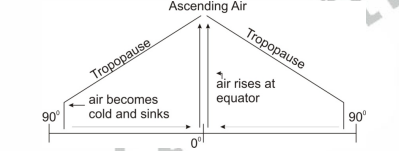
B. Tri – Cellular Meridional Circulation Model
- Given by Ferrel
- He suggested 3 interlocking cells of circulation to explain the wind system of the whole.
- According to him between the tropical and polar cells, there are intermediate mid-latitude thermally indirect cells later named Ferrel Cell.
- The first cell is called the Thermally Directed Hadley cell which operates between 30-degree latitudes in both hemispheres.
- The second is a thermally indirect Ferrel Cell which operates between 30-degree and 60-degree latitudes in both hemispheres.
- The third cell operates between 60 degrees and 90 degrees (poles) in the northern and south hemispheres and is called a thermally direct cell.
- His assumptions were:
- The surface is flat and homogeneous
- Earth is perfectly spherical
- He also considered the role of rotation as well as the Coriolis force.
- Note: Coriolis force: Capable of deflection of the free-moving body.
- In the North Hemisphere: the body moves right, South Hemisphere: the body moves left.


- According to Ferrel, the wind rising at the equator sinks at the subtropical latitude at 30-35
- degree North and South, this is the consequence of Coriolis deflection that forces sinking,
- hence high pressure at the subtropics is dynamically induced. The air from subtropics moving
- along the surface meets the cold air coming from the poles and the air is forced to rise at
- subpolar latitude (around 60-65 degrees N & S). Sub-polar low pressure is also dynamically
- included. Three cells per hemisphere so called as Tricellular model.
- Evaluation:
- The model is the improvement of the Hadley model.
- It is not a difficult model; easy to understand.
- It can explain global planetary winds.
- It can explain broad latitudinal patterns of climate.
- The model cannot explain local winds during monsoon.
- One big limitation of this model is it assumes that there are vertical cells that operate right up to the upper troposphere and does not discuss the nature of upper tropospheric circulation.
C. Wave theory Model of Atmospheric circulation or Modern Dynamic Model
- The wave theory model is based on the concept of transfer of heat energy and angular momentum.
- This model emphasizes the horizontal transfer of energy and angular momentum rather than meridional transfer in a vertical plane.
- This is achieved only when air progressively increases its, speeds toward poleward and this requires pole wards transfer of angular momentum.
- Under this model,
- Shallow circulation is like the Ferrel’s model more or less within 5-6 km of height.
- The upper air circulation is a different system
- Upper tropospheric winds are westerlies at all latitudes.
- In the higher latitudes, upper tropospheric westerlies have sharp north-south meandering paths called Rossby Waves.
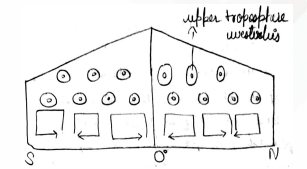
D. Global Computer Model
- Global computer models GCMs are tools for weather forecasting based on real weather phenomena and involving laws of physics and mathematics. Principles such as laws of motion, principles of thermodynamics basic equations related to atmospheric motion and airflow, and hydrostatic equations.
- The GCMs are sets of computer-generated maps of weather conditions of an oval atmosphere and these are used to predict future conditions.
- It may be mentioned that ample data on temperature, pressure, and humidity at numerous centers of the earth’s surface and up in the atmosphere with short distances are required for weather forecasting and predicting atmospheric circulation but GCMs use sample data of sample points whether at the earth’s surface at different altitudes in the atmosphere, mainly in the troposphere, and hence result may not be accurate.
Pressure Patterns on Surface with Land Water
- Differential/Cellular Patterns of Pressure
- Pressure patterns on the globe are not continuous belts everywhere. It depends on the unicellular model, the Tri-cellular model, and the actual pattern based on water differential.
- The real earth has a disruption in the zonal pattern caused by large land masses.
- These disruptions break up pressure zones into semi-permanent cells.
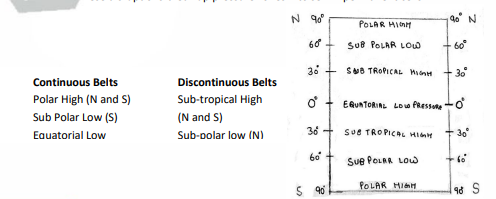
Permanent Cells
- Sub Tropical High (N. Hemisphere) – 2 Permanent Cells
- Azores high (Atlantic Ocean)
- Hawaiin High (Pacific Ocean)
- Sub Tropical High (S. Hemisphere) – 3 Permanent Cells
- Pacific Cells
- Atlantic Cells
- Indian Ocean Cell – Mascarene High
- Sub Polar (N. Hemisphere) – 2 Permanent Cells
- Icelandic low – Atlantic Ocean
- Aleutian low – Pacific Ocean
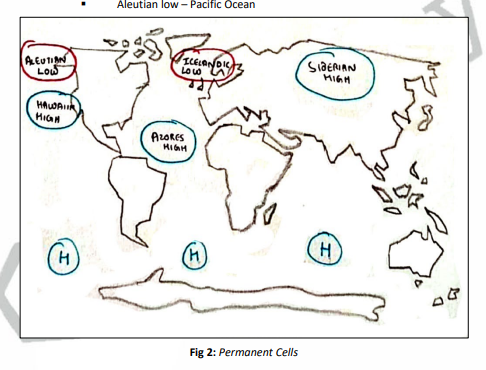
Seasonal Cells on the Continents
- Siberian and Candian High in winter. In summer high pressure disappears
- Colorado Low – North America
- Tibetan Low – Asia
- Saharan Low – Africa
- Sub tropical latitudes of the Southern Hemisphere, there is a strong Australian low pressure, but no significant low pressure in South America or Africa.
- The above patterns of pressure cells are still very simplistic because the effect of Altitudes, local winds, and upper tropospheric winds is not incorporated into the model.

Coriolis Force
- The direction of surface winds is usually controlled by the pressure gradient and rotation of the earth. Because of the rotation of the earth along its axis, the winds are deflected. The force which deflects the directions of winds is called deflection force/Coriolis force [named after famous scientist G.G. Coriolis 1792-1843)]
- Because of the Coriolis force, all the winds are deflected to the right in the Northern Hemisphere while they are deflected to the left in the Southern Hemisphere concerning the rotating earth.
- It may be mentioned that the Coriolis force is not in itself a force in a real sense rather it is an effect of the rotational movement of the earth and hence is also called as Coriolis Effect.
Characteristic Features
- Coriolis force is not in itself a force rather is an effect of the rotational movement of the earth.
- Coriolis force becomes effective on any object that is in motion (i.e. wind, flying birds, aircraft, ballistic missiles, long-range artillery fire, etc.)
- Coriolis force affects wind direction and not the wind speed as it deflects the wind (and other moving objects) direction from the expected path.
- The magnitude of Coriolis force is determined by wind speed the higher the wind speed, the greater is the deflection of wind direction due to the resultant greater reflective (Coriolis force).
- It becomes maximum at the poles due to the minimum rotational speed of the earth while iT becomes zero at the equator.
- It always acts at right angles to the horizontally moving air and other moving objects.
- The net effect is that the horizontal winds are deflected to the right in the Northern Hemisphere and to the left in the Southern Hemisphere.
- The magnitude of deflection (Coriolis effect) is directly proportional to
- The some of the latitude (sin00 = 0, sun 900=1)
- The mass of the moving body
- Horizontal velocity of the wind
- Coriolis force can only change direction and not the velocity of the moving body but deflection depends on the speed of the body. This force is perpendicular to the moving wind.
Wind Direction and Related Laws
Ferrel’s Law and Buy Ballot’s Law
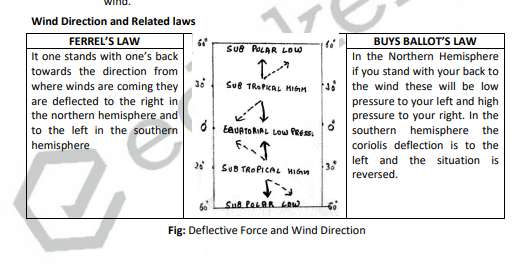
If one stands with one’s back towards the direction from where winds are coming they are deflected to the right in the Northern Hemisphere and the left in the Southern Hemisphere. In the Northern Hemisphere if you stand with your back to the wind will be low pressure to your left and high pressure to your right. In the southern hemisphere the Coriolis deflection is to the left and the situation is reversed.
Frequently Asked Questions (FAQs)
Q1: What causes atmospheric circulation?
A1: Atmospheric circulation is primarily driven by the unequal heating of Earth’s surface by the sun. The equator receives more direct sunlight, causing air near the equator to warm and rise, creating a low-pressure area. As this warm air rises, it moves towards the poles, where it cools and descends, creating high-pressure areas. This creates a continuous loop of air circulation known as the Hadley, Ferrel, and Polar cells.
Q2: How does the Coriolis effect influence atmospheric circulation?
A2: The Coriolis effect, caused by the Earth’s rotation, plays a crucial role in shaping atmospheric circulation patterns. As air moves from high to low-pressure areas, the Coriolis effect deflects it to the right in the Northern Hemisphere and to the left in the Southern Hemisphere. This deflection influences the formation of trade winds, westerlies, and polar easterlies, contributing to the complex global wind patterns and atmospheric circulation.
Q3: What is the significance of atmospheric circulation in climate regulation?
A3: Atmospheric circulation is vital for distributing heat around the Earth, regulating global temperatures, and influencing climate patterns. It helps balance temperature extremes by redistributing heat from the equator towards the poles. This process is crucial for the formation of weather patterns, such as the development of monsoons, trade winds, and the jet stream. Understanding atmospheric circulation is essential for predicting and comprehending long-term climate trends and variations.
In case you still have your doubts, contact us on 9811333901.
For UPSC Prelims Resources, Click here
For Daily Updates and Study Material:
Join our Telegram Channel – Edukemy for IAS
- 1. Learn through Videos – here
- 2. Be Exam Ready by Practicing Daily MCQs – here
- 3. Daily Newsletter – Get all your Current Affairs Covered – here
- 4. Mains Answer Writing Practice – here
Visit our YouTube Channel – here

